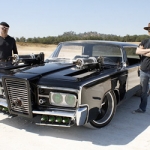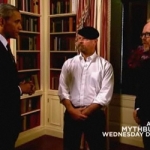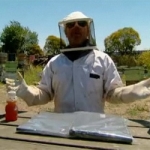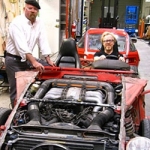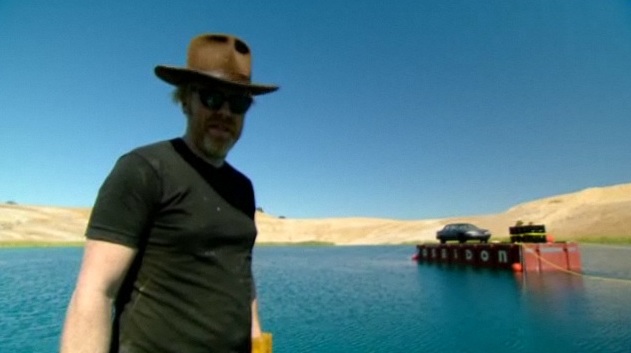
Episode: MythBusters 8.25 – “Inverted Underwater Car”
Original Air Date: November 24, 2010
Although more famous for blowing things up, MythBusters has also been a lifesaver — the 2007 episode “Underwater Car” is credited with giving several people that we know of the knowledge necessary to be able to escape from a sinking car. The fans are not satisfied, however, so in this episode Adam once again puts his life on the line to find out what happens when the sinking car is upside down. Can he get out in time? And what’s up with shooting through a milk carton to prevent a gun’s muzzle flash from igniting a leaky gas oven? Keep reading to find out (unless you don’t want to be spoiled).
Myth #1: The techniques that Adam used in 2007 to escape from a sinking car (staying calm and waiting for the car to fill with water in order for the door to open easily) are useless in most cases, because sinking cars tend to turn upside down.
MythBusters: Adam and Jamie
Procedure 1:
- Build a rig in which the subject will stand while someone else turns it to test whether or not the subject becomes disoriented after turning upside down several times.
- Take the rig to a dive school, where it will go into a swimming pool. Put the subject and tester in scuba gear. Put the subject into the disorientation rig, blindfold him, and turn the rig several times. When it is returned to the upright position, observe the subject to see if he can immediately swim back to the surface. Repeat the test several times and use two different subjects.
Results: Adam was able to determine which direction was up and swim to the surface all three times he was tested. On one of Jamie’s trials, he became disoriented and could not immediately determine which direction the surface was.
Conclusion: The two main reasons cited as causing difficulty in escaping from an inverted car are disorientation and the fact that the air pocket would be at the occupants’ feet instead of at their heads. Although Adam did not become disoriented, Jamie did, and he attributed it to being distracted by sinus problems. The trauma of driving off the road into a body of water and flipping over could definitely be distracting enough to disorient someone trying to escape from the car, so a full-scale test is warranted.

Procedure 2:
- Take a car, a barge, six large, empty barrels, and a lot of rope to a lake in an old quarry.
- Place the car on the barge. Tie the car to the barge and attach the barrels to the car with ropes so that the car will not sink below 15 feet. Take a very long rope and tie one end to the back bumper of the car and the other end to the bumper of a truck on shore. Securely fasten emergency air tanks in several places inside the car.
- Drive the tow vehicle away from the lake, pulling the car off of the barge and flipping it over.
- Observe the subject as he tries to escape from the car. Determine if he is able to stay oriented and calm until the vehicle fills with water and he can open the door, or if has to use the emergency air or break a window to escape.
Results: The car began to sink nose-first and upside down. It then righted itself, but soon after turned upside down again. Adam was able to get the door open and swim to the surface, but not without using the emergency air.
Conclusion: The fact that the car turned over several times disoriented Adam, along with the challenge of staying in an air pocket that kept moving. Once the car was submerged, he was not able to see well enough to find the door handles in his disoriented state. According to the parameters of the experiment — escape using the previously proven methods of staying calm and waiting for the car to fill, then opening the door and swimming to the surface — the myth is confirmed — it is much more difficult to escape from a car underwater when it has “turned turtle.”
Myth #2: Shooting a handgun through a carton of milk will prevent the gun’s muzzle flash from igniting a room full of natural gas, as shown by Morgan Freeman’s character in the movie Kiss the Girls.
MythBusters: Kari, Grant, and Tory
Procedure 1:
- Build a mock-up of a kitchen, transport it to the bomb range, and set it up, complete with cabinets, appliances, and dummies representing Morgan Freeman and the bad guy from the movie scene in question.
- Set up a remote-firing rig with a 9mm Sig Sauer handgun (the type of gun Morgan Freeman’s character is seen carrying in this scene and throughout the film), pressed against a carton of milk. Also put a road flare in the room with a remote ignition to show whether or not there is the right amount of gas in the room if the gun does not ignite it.
- Determine the optimal percentage of methane gas (the main component of natural gas) in the room for igniting the gas. Insert a hose through the wall and fill the room with that amount of gas.
- Fire the pistol through the milk carton and observe the room for an explosion. If there isn’t one, light the flare to cause the explosion and clear the gas from the room.
- Reset the room without the milk carton and repeat step 4.
Results: There was no explosion when the gun was fired through the milk carton. There was also no explosion when the gun was fired without a carton of milk in front of it.
Conclusion: Shooting through a carton of milk does not keep the room from exploding, because the muzzle flash from the gun is not sufficient to ignite the gas in the first place. Myth seems to be busted, but what is really happening with the muzzle flash might be clearer with some small-scale testing.
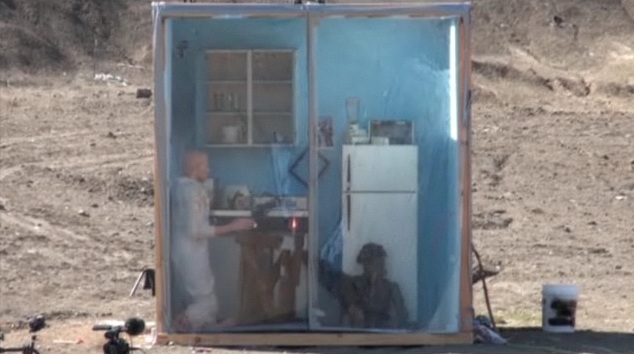
Procedure 2:
- Build a scale model of the room using clear material. Put a hole in one side for the gun to fire through. Set up the remote-firing rig with the Sig Sauer. Set up the high speed camera to record the experiment.
- Fill the box with the appropriate amount of methane gas. Fire the handgun through the box.
- Look at the high speed camera footage to determine the amount of muzzle flash.
- Replace the Sig Sauer with a Glock 9mm pistol (the type of gun the movie’s villain says that Morgan Freeman has). Repeat steps 2 and 3.
- Replace the Glock with a .44 Magnum revolver (shown in previous myths to have a lot of muzzle flash). Repeat steps 2 and 3.
- Analyze the results.
Results: The high speed camera shows a muzzle flash for each gun, but none of them ignite the gas.
Conclusion: The myth is still busted, but in true MythBusters fashion the next step will be to try to create a scenario where the muzzle flash will cause an explosion and then see if it is prevented by the presence of a carton of milk.
Procedure 3:
- Use the same small-scale setup as in test 2 but fill the box with hydrogen gas instead of methane. Fire the Sig Sauer into the box and observe to determine if there is an explosion.
- If the Sig Sauer does not cause an explosion, repeat the test with the Glock. If there is still no explosion, repeat the test with the .44 Magnum.
- Build a larger scale mock-up of the kitchen (dollhouse-sized — the amount of hydrogen needed to fill a full-sized room would create an extremely dangerous situation) and place two guns inside it, one with a carton of milk in front of it and one without.
- Fill the model with hydrogen gas. Fire the milk carton pistol. If there is no explosion, fire the other pistol.
Results: In the small-scale test, the Sig Sauer did not cause an explosion. The Glock did. The .44 Magnum was never tested with hydrogen gas because the Glock test resulted in the destruction of both the box and the high speed camera. In the larger scale mock-up, the second pistol was never fired because firing the first pistol resulted in an explosion despite the presence of the milk carton.
Conclusion: This myth is well and truly busted, and on two separate levels. Not only is the situation shown in the movie busted because the milk wasn’t necessary — the muzzle flash wouldn’t have caused an explosion to begin with — but also because in the presence of a gas that can be ignited by the muzzle flash from a hand gun, the milk won’t do any good.
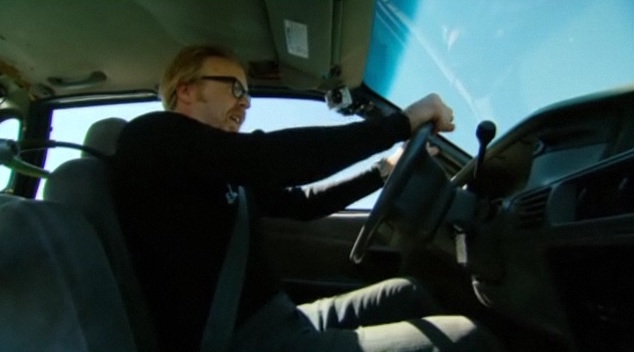
Episode Conclusions: Note to MythBusters producers: stop giving Kari, Grant, and Tory silly movie myths to bust, please! Hollywood special effects are just that — special — and are meant for show, not for accuracy. Accurate explosions and physical reactions are rarely as spectacular and exciting as the things most moviegoers want to see. I think they have about exhausted this particular source, and I for one would like to see them do more interesting and less predictable things. On the other hand, Jamie and Adam had no spectacular explosions but came up with interesting results nonetheless, and they almost satisfactorily addressed their viewers’ concerns. Adam stated at the end of the show that he would definitely make sure that he kept in his car one of the tools made specifically for breaking automobile glass in emergency situations, because he was not able to escape from the inverted car like he did in the earlier episode when the car was right side up. I think there were too many variables to make that blanket statement, though, chief among them being the fact that the car righted itself and then turned upside down again. Is that as common as turning upside down? That is never addressed, at least on screen. What about the windshield that shattered when the car hit the water upside down? Adam mentions it while in the car, but in the analysis afterwards they don’t mention the possibility of being able to escape sooner by kicking out the glass if the impact happens to shatter it. Not a bad episode, but not the best, either, just average.
Rating: 3 / 5 Stars



